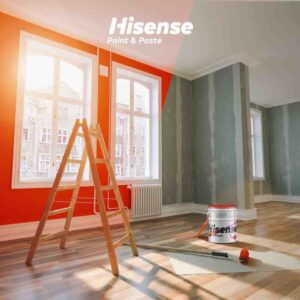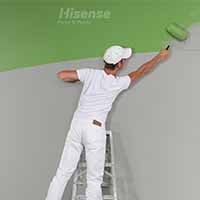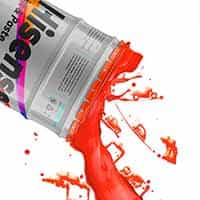What is oil paint?
Oil paint is one of the most widely used and best choices for painting. These paints contain natural oils such as linseed oil or synthetic alkyd. So oil-based paints are often called “solvent-based” or “alkyd” paints.
Alkyd paints are made from an alkyd resin dissolved in a thinner. They all contain pigment and resin in a solvent thinner (or 402). When the thinner evaporates, the paint resin forms a hard coating.
These paints contain a very high level of volatile organic compounds (VOC), which makes the smell of the paint very noticeable.
Painters use oil paint for any surface where the color should last a long time. Also, when using these colors, the effect of the movement of the brush or roller does not remain on the desired surface.
At Aref Chemical Co. we offer the best and highest quality alkyd primer paints with the Hisense brand at a competitive price. Visit our products page and contact us for a free consultation and information on the parts and methods of exporting to your country.
Properties of oil paint:
These paints are very durable and resistant and can withstand the normal contact that you make on the surface of the paint. They are an ideal choice for painting walls, doors, and windows. Because the oil-based resin creates a hard coating that isn’t breathable, this option resists stains and rust over time.
Keep in mind that oil-based paints have a stronger odor than water-based paints and take longer to dry. The use of these paints is decreasing due to harmful environmental effects and long drying times and unpleasant smells. Because the solvent of these paints is oil thinners, which are not suitable for the environment.
If the quality and durability of the paint are important to you, the first suggestion of Aref Chemical is oil paint; But if you want the painting to be done sooner and be easier, use water-based paints (acrylic or plastic).
Advantages and disadvantages of Oil Paints:
Oil paints have better surface penetration and adhesion than other paints. The glossy surface of these paints makes them resistant to stains and makes them easier to clean the paint. For this reason, they are a good choice for stained surfaces, knots of wood, and metals that have rust.
In fact, these paints are very durable and resistant to moisture and are hard enough to withstand daily wear and tear. Oil paints are widely used for high-traffic areas in the home, such as hallways and children’s playrooms.
They are also good options for bathrooms, kitchens, toilets, cabinets, and furniture.
In fact, it can be said that the use of waterproof paints in places that are constantly exposed to water and moisture gives the consumer the confidence that the paint will not deteriorate for a long time and will remain as it was on the first day.
On the other hand, oil paints on surfaces do not stain easily and resist fading over time. These paints keep the shine of this uniform color for a long time.
In addition, since these paints have a high covering ability, the desired surface can be painted without complete preparation or removing the color.
Advantages of Oil Paint:
- Decent brightness
- Suitable for places with high humidity
- Good and flat coverage
- Lasting and durable
- Versatility and usability and implementation on different levels
- High adhesion
- Resistance to mold growth
Disadvantages of Oil Paint:
- The release of toxic and harmful substances for breathing
- Hard to use and implement
- Ability to clean hard surfaces
- Needs a long time to dry
Oil Paint Types:
Oil paints are available in the market in three types: Opaque, semi-glossy, and glossy. In the following, we will explain each of these three types.
1- Opaque Oil Paint:
It is usually used to paint surfaces where we don’t want its details (defects) to be seen well. Opaque paint is rougher than glossy and semi-gloss paint and is obviously less resistant to regular contact and constant cleaning of the surface.
- It is less durable.
- This paint has a beautiful and pleasant appearance and beautifies the environment.
- It takes on dirt quickly.
- It is difficult to remove and may damage.
- It has good coverage and high color variety.
- It reflects light less.
- Compared to glossy oil paint and semi-gloss oil paint, it is less washable.
- Its weight is heavier but it has a lower price.
2- Glossy Oil Paint:
The alkyd resin that is mixed in this paint is obtained from the combination of acid and alcohol. The acid in the paint makes it flexible.
Glossy oil paint, which has higher transparency and gloss, is used for painting metals such as fences, wrought iron, doors, windows, etc. It is also used for the color of wooden doors and windows.
- It has a long shelf life.
- Dirt stays in it less.
- It has a stunning shine.
- It reflects light.
- It is easier to clean it than dirt.
- It has good coverage and high color variety.
- It is washable.
- Its price is more expensive than opaque and semi-gloss paints.
- Its weight is relatively less than other oil paints.
3- Semi-gloss Oil Paint:
This type of paint is one of the best choices for painting the house. Because it does not show waves like glossy paint, and unlike matte paint, it has good washability. This is a combination of glossy and opaque paint.
The semi-gloss paint does not show the wave of the wall and is shiny enough to make the painted wall look good.
Diluting Oil Paint:
When using this paint, synthetic thinners are usually used. Odorless thinners can be used for this. This percentage is usually between 10% and 15%.
Usually, one glass of thinner is used for 0.75 liters of oil-based paint, one cup of thinner for 2.5 liters of this paint, one liter of thinner for 7.5 liters of paint, and two liters of thinner for 15 liters of paint.
Although the same proportions are usually used to dilute oil paint, some products may not need a thinner, or a different percentage may be recommended for them.
Therefore, it can be said that the best way to dilute oil-based paints is to pay attention to the information written on the product packaging.
Thinner is used to dilute oil paints, and this is a solvent that has an unpleasant smell, and this name has other names:
- Paint thinner
- Oil thinner
- Oily solvent
- Oil
- 402
Oil Paint Storage Conditions:
Suitable paint has 2 features: 1- it is standard, and 2- it has not passed its expiration date. When buying paint, pay attention to these two very simple and seemingly trivial features.
To preserve the paint, the temperature should be neither too high nor too low. A temperature between 5 and 35 degrees is suitable for storing this paint and you must prevent the paint from freezing due to cold.
These are sensitive to heat because they have a petroleum solvent base, and there is a possibility of fire for them. So they must be kept away from direct heat or even indirect heat so that they don’t catch fire.
Contact us for a free consultation and get more information. Our colleagues at Aref chemical will respond as soon as possible.







12 Responses
I can’t understand what is difference between oil paint and alkyd paint. could you explain more?
oil paints are often called “solvent-based” or “alkyd” paints.
Nice.
Thank you, you explained it very well.
https://qomtamirat.com/
thank you
https://tavatranslation.com/
good luck
https://tavatranslation.com/%d9%81%d8%b1%d8%b5%d8%aa-%d9%87%d8%a7%db%8c-%d8%b4%d8%ba%d9%84%db%8c-%d8%af%d8%b1-%d8%a2%d9%84%d9%85%d8%a7%d9%86/
I love immigration
https://tavatranslation.com/%d8%b2%d8%a8%d8%a7%d9%86-%d8%a8%db%8c%d9%86-%d8%a7%d9%84%d9%85%d9%84%d9%84%db%8c/
good
https://daroosf.com/%DA%A9%D9%85-%D8%A2%D8%A8%DB%8C-%D8%AF%D8%B1-%D9%88%D8%B1%D8%B2%D8%B4%DA%A9%D8%A7%D8%B1%D8%A7%D9%86/
thank you
https://daroosf.com/%D8%AA%D8%A8-%D8%AF%D9%86%DA%AF%DB%8C/
so great and nice
https://daroosf.com/%D8%AA%D8%A8-%D8%AF%D9%86%DA%AF%DB%8C/
It is one of the best choices for painting the room
https://daroosf.com/%DA%A9%D8%A7%D9%87%D8%B4-%D8%A7%D8%B4%D8%AA%D9%87%D8%A7/
I enjoyed it
https://behdama.com/